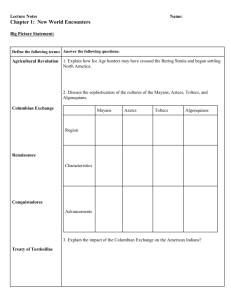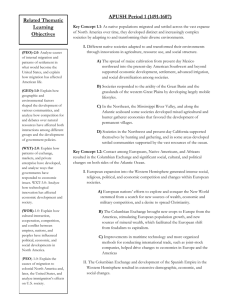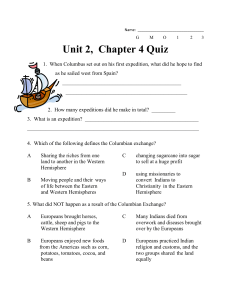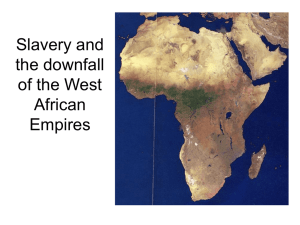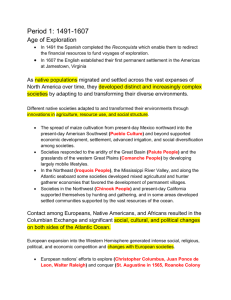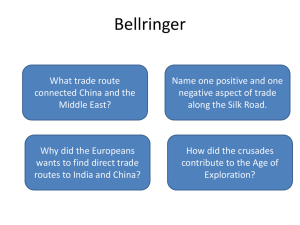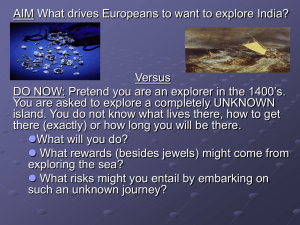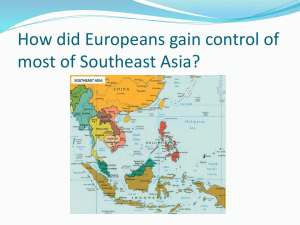Period One Recap
advertisement
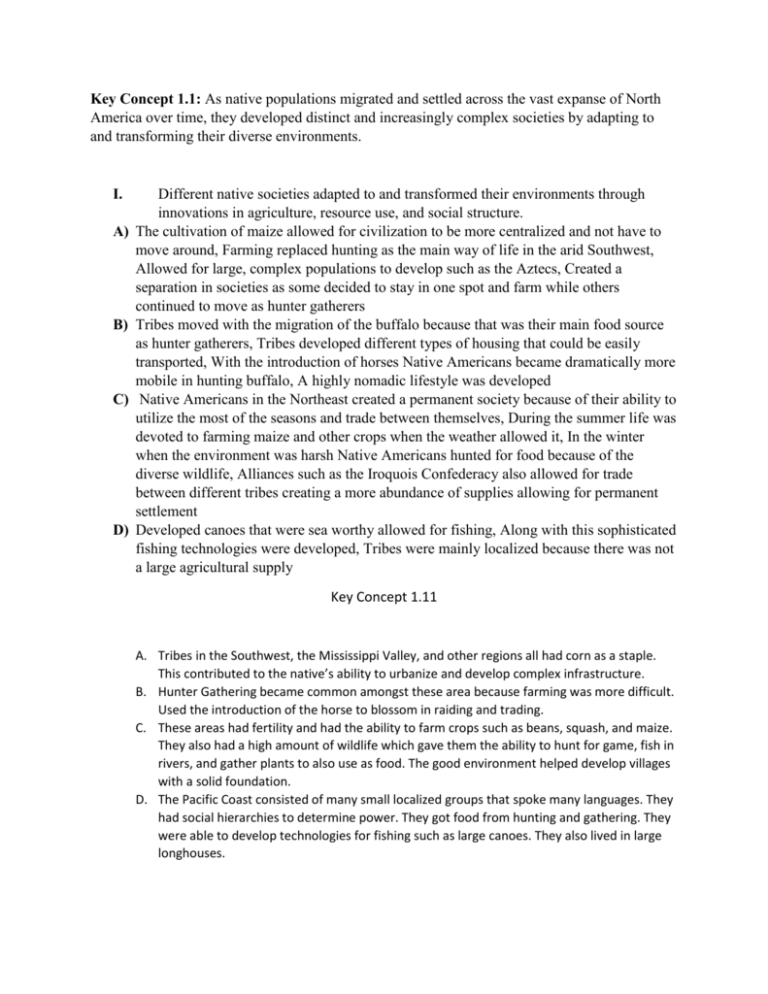
Key Concept 1.1: As native populations migrated and settled across the vast expanse of North America over time, they developed distinct and increasingly complex societies by adapting to and transforming their diverse environments. I. A) B) C) D) Different native societies adapted to and transformed their environments through innovations in agriculture, resource use, and social structure. The cultivation of maize allowed for civilization to be more centralized and not have to move around, Farming replaced hunting as the main way of life in the arid Southwest, Allowed for large, complex populations to develop such as the Aztecs, Created a separation in societies as some decided to stay in one spot and farm while others continued to move as hunter gatherers Tribes moved with the migration of the buffalo because that was their main food source as hunter gatherers, Tribes developed different types of housing that could be easily transported, With the introduction of horses Native Americans became dramatically more mobile in hunting buffalo, A highly nomadic lifestyle was developed Native Americans in the Northeast created a permanent society because of their ability to utilize the most of the seasons and trade between themselves, During the summer life was devoted to farming maize and other crops when the weather allowed it, In the winter when the environment was harsh Native Americans hunted for food because of the diverse wildlife, Alliances such as the Iroquois Confederacy also allowed for trade between different tribes creating a more abundance of supplies allowing for permanent settlement Developed canoes that were sea worthy allowed for fishing, Along with this sophisticated fishing technologies were developed, Tribes were mainly localized because there was not a large agricultural supply Key Concept 1.11 A. Tribes in the Southwest, the Mississippi Valley, and other regions all had corn as a staple. This contributed to the native’s ability to urbanize and develop complex infrastructure. B. Hunter Gathering became common amongst these area because farming was more difficult. Used the introduction of the horse to blossom in raiding and trading. C. These areas had fertility and had the ability to farm crops such as beans, squash, and maize. They also had a high amount of wildlife which gave them the ability to hunt for game, fish in rivers, and gather plants to also use as food. The good environment helped develop villages with a solid foundation. D. The Pacific Coast consisted of many small localized groups that spoke many languages. They had social hierarchies to determine power. They got food from hunting and gathering. They were able to develop technologies for fishing such as large canoes. They also lived in large longhouses. Key Concept 1.2 I a) European nation’s wanted to expand their land to be able to boost their economy and military and spread Christianity. Every European nation wanted to expand their land to seem more powerful. When Christopher Columbus first traveled back from the Caribbean, he told the king that the people there would be easy to convert to Christians due to their lack of weapons and ability to fight back. The Portuguese traveled to Brazil and used their land for sugar plantations to bring in a new source of revenue for their country. b) The Columbian Exchange was a large trade between Europe and the Native Americans. Europeans brought grains like wheat and barley and weeds like dandelions to America. They brought from America potatoes, maize, tomatoes, and other foods that allowed the Europeans to strive and have a balanced diet. This exchange introduced horses, pigs, and cows to America. Europeans also brought over germs such as small pox, influenza, and bubonic plague that killed 90% of the natives they encountered on the first century of contact. The Europeans gained from the gold and silver they found in the Americas. c) Prince Henry of Portugal founded oceanic navigation that led to the building of a better vessel called the Caravel which had a triangular sale. They learned to use the wind and currents to sail further into the Atlantic. This allowed for quicker times to get to further away nations and more opportunity for trade. Key Concept 1.2: Contact among Europeans, Native Americans, and Africans resulted in the Columbian Exchange and significant social, cultural, and political changes on both sides of the Atlantic Ocean. I. European expansion into the Western Hemisphere generated intense social, religious, political, and economic competition and changes within European societies. A) European nations’ efforts to explore and conquer the New World stemmed from a search for new sources of wealth, economic and military competition, and a desire to spread Christianity. a. When Columbus returned to Spain after his first voyage to “India”, he brought back six natives that he baptized with hopes of converting them to Christianity, having described them as easily convertible. He also brought back “samples of the finest gold”. Ferdinand and Isabella had “sought trade and empire” through Columbus’ “discoveries”. B) The Columbian Exchange brought new crops to Europe from the Americas, stimulating European population growth, and new sources of mineral wealth, which facilitated the European shift from feudalism to capitalism. a. Not only did they bring back great amounts of gold from the Americas, but they also took advantage of other resources. For example, a tree in Brazil holds a valuable red dye. Slaves became a key part of agriculture and the new economy. Europe was introduced to a plantation system rather than small farms, perfectly showing the shift from feudalism to capitalism. C) Improvements in maritime technology and more organized methods for conducting international trade, such as joint-stock companies, helped drive changes to economies in Europe and the Americas. a. Da Gama, for example, had a stronger fleet of ships on his side to be able to transport his findings back to the Americas. The Portuguese also did very well with naval technology, as Prince Henry of Portugal founded a center for oceanic navigation, eventually designing a better-handling vessel. Key Concept 1.2: Contact among Europeans, Native Americans, and Africans resulted in the Columbian Exchange and significant social, cultural, and political changes on both sides of the Atlantic Ocean II. The Columbian Exchange and development of the Spanish Empire in the Western hemisphere resulted in extensive demographic, economic, and social changes. A. The reason the Spanish was able to take over was because disease wiped out population and crops because the natives and agriculture were not immune to it. When the Spanish came over they brought things over like crops and animals that weren’t already there, so they destroyed what was already there. B. When the Spanish came over, they instituted a system involving the labor of the natives. They discovered that there were cash crops that allowed them to make money using unpaid laborers that they can capture in the Americas and use for profit. This also were true for many different resources including mining gold and silver. C. The Spanish started to engage in trade with West Africa which eventually led them to start trading with slave traders. They then used these slaves for agriculture and mining in the Americas. D. The Spanish created a sort of hierarchy that sorted the different populations of the different countries. This put them in their difference place and set an example for what they should do. Key Concept 1.2: III A) Upon the arrival of the European’s, the Natives were afraid of them because of their weapons and the fact that they were even there on the land. The Europeans immediately thought that the Natives were savages because of the way they lived their lives. After some time, the two groups were able to trade with each other to get the items they needed to survive, adopting some of each other’s culture. B) As the Europeans traveled further into the new land, the Natives saw how different the European’s beliefs were on the topics of religion and gender relations. The Europeans became more aggressive and tried to conquer the land rather than share it, so the Natives attempted to fight back with military as well as negotiations. Their fighting proved ineffective because their technology was less advanced, and the Europeans ignored many if not all peaceful ideas. C) Native and Africans provided cheap labor though they were often treated as if they were less than human. This was frowned upon in the colonies but it was good for the economy, so it continued. Due to the dependence on this cheap labor, it is still debated today. Key Concept 1.2: Contact among Europeans, Native Americans and Africans resulted in the Columbian Exchange and significant social, cultural, and political changes on both sides of the Atlantic Ocean III. In their interactions, Europeans and Native Americans asserted divergent worldviews regarding issues such as religion, gender, roles, family, land uses, and power A. Due to the cultural differences of the Europeans and The Native Americans there were conflicts over ownership of land. Religious differences due to Europeans strong desire to spread Christianity, and Native American’s strong belief in animism. One of the useful aspects that both groups adapted from each other was farming and holidays such as Thanksgiving. And Native Americans got weapons like rifles from the Europeans. B. Iroquois Confederacy and other pacts similar to it formed from Native American’s act of defense against European encroachments. In Jamestown, Native Americans cooperated by surrounding the Europeans and eventually starving them to death. Wage of War against the Europeans was the most common defense for the Native Americans. C. The Native Americans were treated as an outsider due to their lack of knowledge in Christianity, while The Europeans thought they were superior. In Africa, the crusader’s method of converting Muslims to Christians included brutal killing, deportation, and violence.

